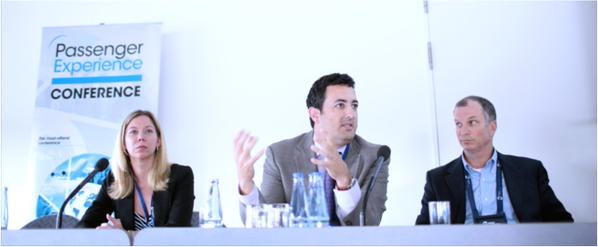[Avionics Today 04-13-2015] As solutions providers look to strengthen the business case for airlines to invest in high-tech In-Flight Connectivity (IFC) solutions, a drive to improve operational efficiency is taking center stage. This was one of the main findings of this year’s Passenger Experience Conference in Hamburg, Germany, taking place today. Mike Moeller, vice president of sales and marketing for In-Flight Entertainment and Connectivity (IFEC) at Thales spoke at the conference, noting that, as bigger satellites are coming online, airlines can see affordable solutions on the horizon, but providers are turning their focus to operations, as much as the passenger experience.
 |
| Panelists at the “The Inflight Entertainment and Connectivity Debate: The Future for Inflight Content” session during the Personal Experience Conference in Hamburg, Germany. Photo: Spafax |
“We all believed that initially passengers would pay for this by the droves. Now, we have to find other business models. Operations is the next best way to close the business case,” Moeller said.
Andrew Kemmetmueller, vice president of airline applications at Gogo, said that while most airlines have initially started with offering connectivity to the passenger, things are starting to change. According to Kemmetmueller, Gogo is looking into how the company can help make airlines more efficient through connectivity by enabling airlines to access and use big data, as well as how airlines can benefit from other applications such as cloud computing.
While airlines and providers alike are aiming to improve operational efficiency, the desire to upgrade the passenger experience is still important given the increasing numbers of passengers with Personal Electronic Devices (PEDs) onboard aircraft. Ian Dawkins, chief executive officer of OnAir — a connectivity provider that services more than 40 commercial airlines — told attendees that we now live in a different environment. According to OnAir and SITA’s own research, around 97 percent of passengers carry a PED when flying the skies, and those with devices want to be able to connect them. He also noted that a lot of passengers are carrying more than one device.
Operationally, Dawkins sees connectivity creating new opportunities for aircraft crews. “They [the crew] want to be connected. What is important is having their tablet integrated into the airline IT infrastructure. This connectivity provides real-time passenger information. It can help with baggage tracking, e-health services, etc.”
Dawkins cited a recent case study with Russian airline Aeroflot in which 2000 Aeroflot employees were connected and able to access a variety of information as part of a trial. Dawkins said this recent trial with Aeroflot had been a success, with a high satisfaction rate among the crewmembers who took part.
Operational savings through connectivity can be significant, with Dawkins citing Air China’s upgrade to real-time weather updates, which saved $8 million a year through improved fuel efficiency. “We are touching the tip of the iceberg on what are the benefits going forward,” he admitted.
Dawkins calls the next generation of aircraft “flying data centers.”
“They are providing a lot of information to the ground,” Dawkins added. “The reality is they are becoming difficult to operate. There have very few resources for airlines to manage this data effectively. We are looking at aircraft health and maintenance solutions. We can enable predictive maintenance through the acquisition and analysis of real time aircraft data, avoiding unplanned maintenance during turnaround and improving reporting. The connected aircraft is pretty complex.”
Axel Jahn, chief executive officer at TriaGnoSys, agreed with this sentiment, but noted that enhanced security is also key. “Aircraft will become part of an overall IT infrastructure,” said Jahn. “There is an aspect of how you can protect your data. This aspect of data security will become more important.”
Richard Nordstrom, senior director of global marketing at Rockwell Collins, spoke of the potential of aircraft-to-aircraft communications to improve overall efficiency. “I think we will see HD weather being shared between different aircraft over the next 3 to 4 years,” said Nordstrom. “This can be definitely used to improve efficiency.”
Content Side
There was also a discussion on the latest trends when it comes to content. “We have to be sensitive to what the airlines want, and the experience they want to deliver,” Robin Cole, vice president of global business development at Global Eagle Entertainment, commented. “Connectivity is enabling new scenarios such as Netflix and HBO Now. This is what customers are starting to expect. Airlines are looking to simulate that experience. At the moment, quantity is still a differentiator, but in the future that will change. In the future, a focus on quality will become important. Providing content that goes along the airline brand will be when things get more interesting here.”
Don Buchman, vice president of ViaSat said the biggest surprise from passengers was that they can use streaming video services such as Netflix, noting that the main aim of enhancing technology is to enable the home experience on the aircraft. With JetBlue as one of ViaSat’s main customers, Buchman said social media is key to the JetBlue experience, particularly amongst younger passengers. Finding a way to better integrate social media into the whole experience is one of the trends the company expects to emerge going forward.